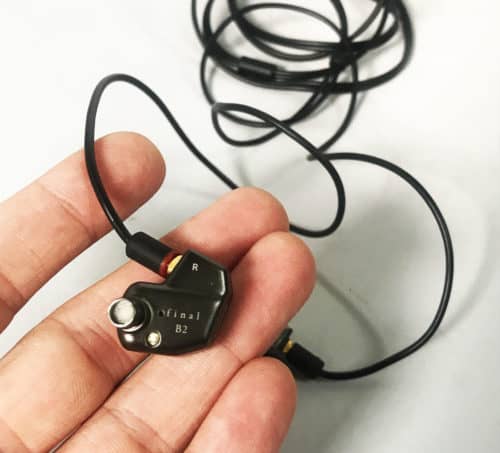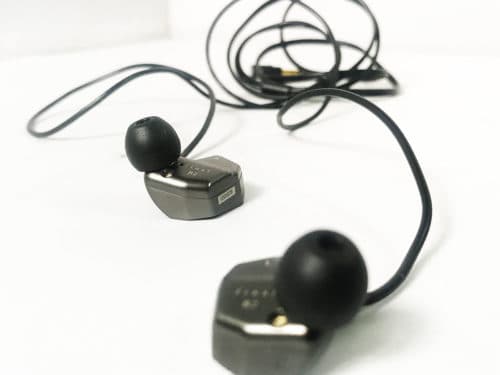Continuing on my quest of trying out the IEMs of the B-Series, this week I got a chance to spend some quality time with the most affordable of the series, the Final Audio B2. With a single balanced armature driver, how does it perform? Let’s take a closer look with this Final Audio B2 Review.
Final Audio B2 Review
In the Box
-Final Audio B2 IEMs
-Detachable MMCX cable with 3.5 mm connector
-Final Audio E-type eartips
-Earhooks
-Cable removing grip
-Silicone carrying case
-Documentation
Design
Look and Feel

The Final Audio B2 has a classy, mature design, featuring the same housing shape and size as the MAKE series. Its driver housing is made of albuminum, and has a dark, matte silver look. Combining hard and soft edges, the geometric shape of the B2 looks striking against its competitors.
In my hands, the Final Audio B2 feels strong and sturdy. Its driver housings have a little bit of a sense of weight. Likewise, the MMCX connection feels extremely secure.
Comfort and Fit

Because of its unique, angular shape, the Final Audio B2 fit extremely easily in my relatively small ears. I found a seal in my ear canal almost immediately. It has a medium size to its driver housing, so will work well for most ear sizes. Additionally, it was a comfortable fit, not feeling too tight.
Cable

The cable of the Final Audio B2 was a solid, manageable length and had a small footprint. Its MMCX connectors felt strong and secure. The conductors of the individual sides fit in the same jacket. Then when the wires of the left and right meet in the middle, they run alongside each other, staying in their individual jackets. Finally, the cable terminates to an L-shaped 3.5 mm connector.
Driver
While there isn’t much information on the Final Audio B-series yet, the Final Audio B2 has a single balanced armature driver. According to Final Audio, it’s sound should be quick with a wide dynamic range. Let’s get into the sound!
Sound
Low Frequencies

The low frequencies of the Final Audio B2 sound clear and even with a little bit of a boost around what sounded like 60 Hz. Additionally, have reach deeply, having a subtle feeling of extension to them. However, the overall level of the lows is a little bit light. Kick drums, for example, have a sense of punchiness in overall feel to them, but sit slightly quieter than a basshead might prefer. Their subtlety has nuance, and as a result, this low end works well for genres that don’t need too much extra bass boost, but still benefit from tightness and a little punch.
For example, when I was listening to the song Desperado by Rihanna, the bass synth reaches deeply and provides a feeling of groove to the song. However, it is a little bit quieter in the mix than I usually prefer. Its role remains impactful because of its clarity and thus consistent sustain.
Middle Frequencies

The middle frequencies of the Final Audio B2 are clean and clear, with a feeling of quickness and fullness. With emphasis in the low-mids around what sounded like 150-200 Hz, bass guitars, low cellos, pianos, and synths have a sense of separation from the lows below them. Additionally, I was impressed because these instruments also seemed to have a feeling of separation between the midrange instruments above them. In addition to its low-mid boost, even greater emphasis is placed on the high-mids, around what sounded like between 2 kHz and 4 kHz. This emphasis brings forward the snaps and attacks of drums, as well as vocals and hammers of pianos. There is an interesting feeling of separation with these IEMs, one that marries togetherness and separation. As a result, mixes feel solid and uniform, while also showcasing individual instruments.
For example, when I was listening to the song Roosevelt Room by Conor Oberst and the Mystic Valley Band, the snare drum and the vocal sounded a bit more forward than usual, giving them clarity and articulation. Both seemed to have a feeling of spaciousness around them. Additionally, the bass guitar reached deep, and felt wonderfully separated from the electric guitars, organs, and keys. Those guitars, organs, and keys had harmonic complexity and thickness, making this mix big and fun sounding! However, I was most impressed by the interesting feeling of separation between these three instruments. Each had a sense of solidity and similarity in how they served the mix, however, they each had separation from each other at the same time, even revealing new parts I hadn’t heard before. However, they didn’t feel so separated that they made the mix feel incohesive.
High Frequencies

The high frequencies of the Final Audio B2 sounded a little bit moderate in general. A boost at 7 kHz is where the majority of the high-frequency energy seemed to center, providing articulation to vocals, drum attacks, horns and keys. However, a substantial cut began around what sounded like 8 kHz, which gave the high frequencies a bit of a feeling of subtlety. A little boost around 10 kHz brought back a little extra textural detail. And while I did feel a little bit of a sense of extension, it was too quiet in the mix to have a substantial impact on the feel as a whole.
For example, when I was listening to the song Stuff by Miles Davis, the trumpet felt present and closer in space in the mix than usual. Additionally, the open/closed high-hat pattern had a sense of thickness and chunkiness. However, it, although with the other cymbals, didn’t feel as crisp as usual. While they all had a sense of sustain, texture, and harmonic complexity, they felt a little bit modest in the mix level-wise.
Soundstage
The soundstage of the Final Audio B2 benefited from the feeling of quickness in the midrange. It gave a greater feeling of movement to wide-panned instruments. The feeling of depth is skewed a little bit because of the presence of the high-mids and lower treble. However, there is a specificity to instruments placed closely in space and those that are purposely placed far off in the mix. Lastly, while the feeling of height certain benefits from separation, the moderate level of the lows and the high-highs limits the extent of the tallness.
For example, when I was listening to the song Mercy Now by Mary Gauthier, the vocal and snare drum sat more intimately in space than usual due to the high-mid/lower treble boost. However, they contrasted well with the far-off fiddle and mandolin. Additionally, the wide acoustic guitars, pedal steel, mandolin, and had wonderful separation from the middle-focused vocal, drums, and bass guitar. The quickness of the mids gave them extra spaciousness, so they even had nuance among each other. Lastly, while the lowness of the bass guitar certainly contrasted from the highs of the acoustic guitar, vocal, and fiddle, the height felt a little bit short because of the relatively quietness of the high frequencies.
Overview
Overall, the Final Audio B2 has a stylish, mature look, with an easy and comfortable fit. It’s focal high-mid frequencies favor vocal centric music like singer-songwriter, pop and folk. However, its harmonic complexity, quickness, and separation in the midrange also sounds great for jazz, rock, and indie music. If you’re looking for a big bass or extended highs, these won’t be the ones for you. But if you like a nice full midrange with a tuning for voice, you’ll really enjoy the B2.
The Final Audio B2 is available for the best price here:
MajorHiFi may receive commission through retail offers.

Compare the ranking of various headphones, earbuds and in-ear monitors using our tools.
Discuss this, and much more, over on our forum.
---MAJORHIFI may receive commissions from retail offers.















